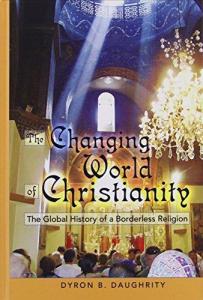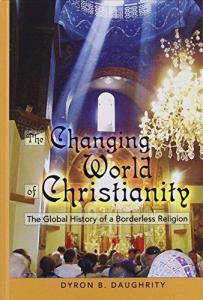 Dyron B. Daughrity, The Changing World of Christianity: The Global History of a Borderless Religion (New York: Peter Lang, 2016).
Dyron B. Daughrity, The Changing World of Christianity: The Global History of a Borderless Religion (New York: Peter Lang, 2016).
Christianity is the world’s largest religion, in terms of adherents, and ranks as the dominant religion, in terms of geography. How it became so and what it looks like today are the subjects of Dyron B. Daughrity’s The Changing World of Christianity. The book is a useful introduction to a vast topic.
To get a sense of Christianity’s size and dominance, consider statistics cited by Daughrity at the outset of his book (pp. 1, 3). In terms of adherents, Christians constitute 33.33 percent of the world’s 6.7 billion people. Muslims constitute 20.87 percent, Hindus 13.41 percent, and nonreligious persons 11.71 percent. No other religion—e.g., Buddhism, Chinese universalist, atheist, etc.—constitutes more than 6 percent. (The statistics are from 2009.)
In terms of ranking, Christianity is the majority or plurality religion in six of the eight geographical regions of the world. The eight regions are, in alphabetical order, Africa, Asia, Eastern Europe, Latin America/Caribbean, Middle East, North America, Western Europe, and Oceania. Christianity accounts for 92.62 percent of the inhabitants of Latin America, 81.44 percent of North America, 79.76 percent of Eastern Europe, 79.74 percent of Oceania, 78.09 percent of Europe, and 46.53 percent of Africa. Only in Asia and the Middle East do Christians represent a minority of religious adherents, at 9.25 percent and 2.45 percent, respectively.
Obviously, these figures represent nominal adherence to a religion, not necessarily personal commitment as measured by church attendance, theological orthodoxy, or spiritual vitality. Moreover, Daughrity’s definition of “Christian” is expansive, including groups that have longstanding theological disagreements with one another—e.g., Nestorians versus Chalcedonians, Orthodox versus Catholic, Catholic versus Protestant, Western versus African Initiated Churches, etc. Still, the expansion of Christianity from a sectarian Jewish group in a minor Roman province in the first century A.D. to a global religion today is impressive.
How did this happen?
To answer that question, Daughrity profiles the eight geographical regions mentioned above, this time, however, in roughly the chronological order in which Christianity spread to them. So, he begins with the Middle East, moves to Eastern Europe and Western Europe, then Latin America and the Caribbean, North America, Asia, Africa, and Oceania.
I say “roughly” because the Christian presence in both Africa and Asia is quite old. For example, Christianity had a presence in North Africa from the first century A.D. onward, becoming the dominant religion of the region by the time of the seventh-century growth of Islam. Nestorian Christianity followed the Silk Road, arriving in China in A.D. 635. Little is left of those ancient churches, however. The growth of Christianity in Asia and Africa is largely a modern phenomenon.
Daughrity’s geographical arrangement of his material, however rough its chronology, brings an important demographic fact to the fore. The center of global Christianity is moving southward. “In 1900, 82% of the world’s Christians lived in Europe or North America; only 18% of the world’s Christians were outside the Euro-North American block. In the year 2005, only 39% of the world’s Christians lived in Europe or North America. During that 105 year period, Christianity’s heartland moved south to the point that over 60% of the world’s Christians now live in Asia, Africa, or Latin America” (p. 14).
Three themes emerge in Daughrity’s regional narratives that explain Christianity’s growth:
First, missions. Christianity is a missionary religion and always has been. Indeed, the first history of Christianity—the Book of Acts—was a history of its witness to Jesus Christ “In Jerusalem, and in all Judea and Samaria, and to the ends of the earth” (Acts 1:8). By the time Constantine converted to Christianity in A.D. 312, the Christianity had established roots throughout the Roman Empire (in both its western and eastern halves), and even beyond the reaches of that empire in, among other places, Persia. Since then, the Christian mission has often been entangled with (and distorted by) imperialism and colonialism. However, in every century and in every region, Christianity has been advanced by the work of pioneer missionaries.
Second, colonialism. The first three centuries of Christian growth—from Jesus to Constantine—took place without political aid and sometimes in the teeth of imperial persecution. Once Constantine converted to Christianity in A.D. 312, however, he initiated the long, productive, but troublesome history of Christianity’s entanglement with state power. Imperialism and colonialism—whether Byzantine in the fourth century, Spanish and Portugese in the sixteenth, or British in the eighteenth and nineteenth centuries—opened new lands to missionaries. Of the eight regions where Christianity is dominant, four were the objects of European colonialism in the last 500 years: Latin America, North America, Oceania, and Africa.
Given the often brutal nature of colonialism—European diseases that destroyed aboriginal populations, exploitation of the land for natural resources, the enslavement and exploitation of native populations—it is surprising that Christianity took hold in these lands. Africa is an especially paradoxical case study. Daughrity quotes the Kenyan Mau Mau revolutionaries as saying, “When the white man came, he had the Bible and we had the land. He told us to close our eyes and pray, and when we opened our eyes he had the land and we had the Bible” (p. 199). Given the truth of this sentiment, it was widely expected that Christianity in sub-Saharan Africa were decline when the colonial powers left. In fact, however, sub-Saharan Africa more than any other geographical region has seen the explosive growth of Christianity. Despite colonial depredations, Africans took the missionary’s Bible and made it their own.
Third, fertility. Most people identify with and practice the religion of their parents. (The rapid conversion of sub-Saharan Africa to Christianity is the exception that proves the rule.) The global dominance of Christianity, then, depends to a degree on the fertility of its adherents. (Again, we are taking about nominal adherence, not necessarily personal commitment.) According to statistics cited by Daughrity (p. 3), Africa has the highest fertility rate (4.72 births per woman), followed by the Middle East (2.88), Latin America/Caribbean (2.42), Asia (2.35), and Oceania (2.26). For a given population merely to replace itself, its birth rate must average 2.1. North America (2.05), Western Europe (1.56), and Eastern Europe (1.38) are all well below replacement rate. Looking at these statistics and noting that the highest birth rates are in Africa and the Middle East, where Islam has, respectively, a sizable minority and majority presence, many demographers predict that Islam’s share of the global population will match or exceed Christianity’s within the twenty-first century. Daughrity acknowledges this demographic trend line but notes that it assumes current demographic trends will continue unchanged into the future. Given the spectacular growth of Christianity in sub-Saharan Africa especially, this may be a problematic assumption.
Daughrity closes his study with a question, “What does Christianity mean?” He notes that some will see Christianity as “having played a critical role in many great human achievements,” while others will associate it with “the atrocious nature of European expansion.” As a historian of religion, Daughrity rejects “the twin temptations of unequivocal praise and wholesale rejection,” opting instead to present the story of Christianity’s growth in all its “messiness” (p. 253). As a student and proponent of the Church’s mission to the world, messy is a good word to use. The gospel is luminous, but Christians throughout the ages have mucked it up in any number of ways.
What is clear today, however, is that Christianity is growing in the global South and declining in the global North. Daughrity notes the historical irony of this when he writes, “global Southerners often see the West as a grand mission field, a spiritual wasteland in need of the gospel. What goes around has come around indeed!” (p. 254). But this time, it will come in an African or Asian or Latin American form.
_____
P.S. If you found my review helpful, please vote “Yes” on my Amazon.com review page.


This is a good review of Dyron B. Daughrity’s book, The Changing World of Christianity, but has one fault in it that I wish to address. This fault is almost always found in any review of books and articles relating to the world-wide growth and demographics of the Christian religion; especially those reviews done by adherents to the Evangelical branch of the Christian church. The “fault” I find in this review is the tendency to make distinction between who is a true Christian versus those whose claim to be believers in Christ is suspect based on their performance, i.e., works. Here below is a typical example of this “fault” via a quote by the reviewer of Daughrity’s book:
“Obviously, these figures represent nominal adherence to a religion, not necessarily personal commitment as measured by church attendance, theological orthodoxy, or spiritual vitality.”
In fact, nowhere in the Scriptures is one’s authentic Christian faith determined by “church attendance, theological orthodoxy, or spiritual vitality.” Rather, one’s claim to “be a Christian” may be summed up in a very simple formula and verse of scripture as follows:
Acts 16:31 (NKJV)…
So [Paul and Silas] said, “Believe on the Lord Jesus Christ, and you will be saved, you and your household.”